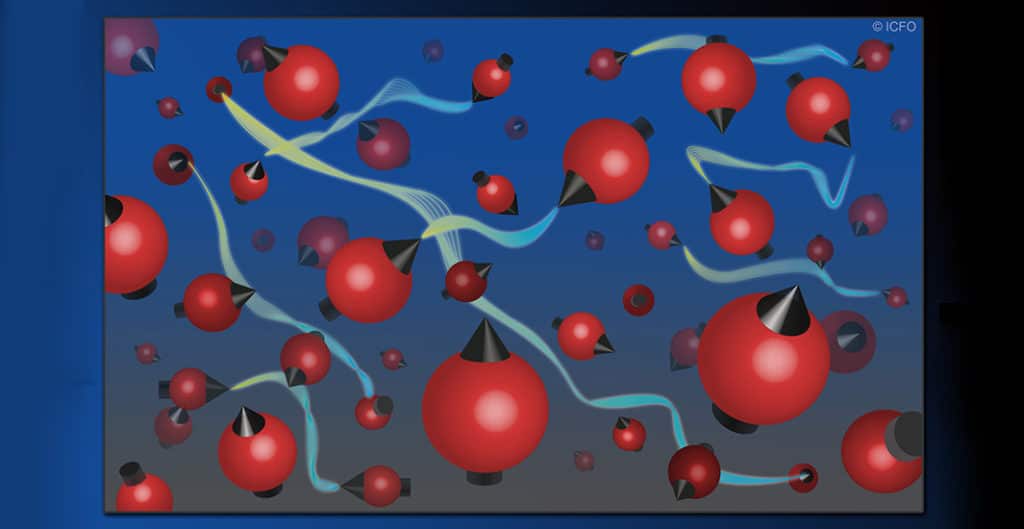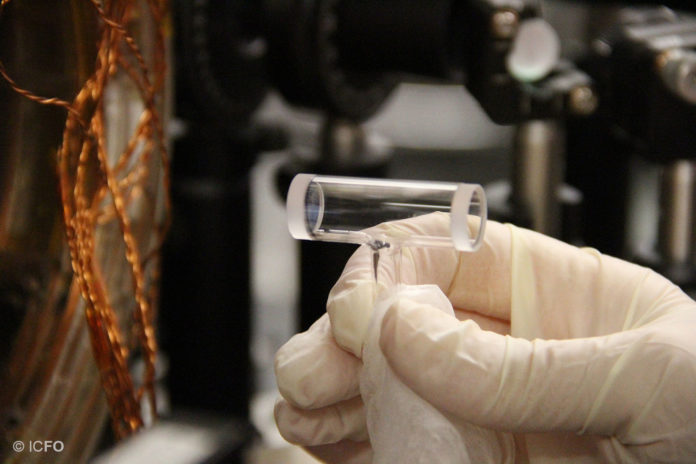Quantum technologies use entanglement to outperform classical technologies, and often employ strong cooling and isolation to protect entangled entities from decoherence by random interactions.
In a new study, physicists at the ICFO report the production of a giant entangled state of 15 trillion atoms that can aid medical researchers to detect too faint magnetic signals from the brain.
Physicists started with heating a collection of atoms to 450 Kelvin, millions of times hotter than most atoms used for quantum technology. Each atom was isolated: they collided with each other every few microseconds, and each collision set their electrons spinning in random directions.
Using the laser, scientists monitored the magnetization of this hot, chaotic gas. The magnetization was the result of the spinning electrons in the atoms that offer a new approach to study the effect of the collisions and to detect entanglement.
Here, scientists observed something surprising: an enormous number of entangled atoms – about 100 times more than ever before observed. What’s more, the entanglement is non-local, i.e., the atoms involved were not close to each other. Between any two entangled particles, there are thousands of other atoms, many of which are entangled with still other atoms, in a giant, hot and messy entangled state.
Jia Kong, the first author of the study, said, “What we saw is that if we stop the measurement, the entanglement remains for about one millisecond, which means that 1000 times per second a new batch of 15 trillion atoms is being entangled. And you must think that 1 ms is a very long time for the atoms, long enough for about fifty random collisions to occur. This clearly shows that these random events do not destroy the entanglement. This is maybe the most surprising result of the work.”
According to scientists, “The observation of this hot and messy entangled state paves the way for ultra-sensitive magnetic field detection. For example, in magnetoencephalography (magnetic brain imaging), a new generation of sensors uses these same hot, high-density atomic gases to detect the magnetic fields produced by brain activity.”

As ICREA Prof. at ICFO Morgan Mitchell states, “this result is surprising, a real departure from what everyone expects of entanglement.” He adds, “we hope that this kind of giant entangled state will lead to better sensor performance in applications ranging from brain imaging to self-driving cars to searches for dark matter.”
Using Bayesian statistics and spin-squeezing inequalities, scientists have shown that at least 1.52(4) × 1013 of the 5.32(12) × 1013 participating atoms enter into singlet-type entangled states. A spin-singlet is one form of entanglement where the multiple particles’ spins—their intrinsic angular momentum—add up to 0, meaning the system has zero total angular momentum.
Later on, a quantum non-demolition (QND) measurement was used to extract the information of the spin of trillions of atoms. This technique works by passing laser photons with specific energy through the gas of atoms.
These photons with this precise energy do not excite the atoms, but they are affected by the encounter. The atoms’ spins act as magnets to rotate the polarization of the light. By measuring how much the photons’ polarization has changed after passing through the cloud, the scientists determined the total spin of the gas of atoms.
Notably, vapor-phase spin-exchange-relaxation-free (SERF) techniques are used for magnetometry, rotation sensing, and searches for physics beyond the standard model, and give unprecedented sensitivity. In this regime, intense, frequent, and randomly-timed spin-exchange (SE) collisions dominate the spin dynamics, to produce local spin thermalization.
In this regime, any atom experiences many random collisions with other neighboring atoms, making collisions the most critical effect on the state of the atom. Also, because they are in a hot medium rather than an ultracold one, the collisions rapidly randomize the spin of the electrons in any given atom.
The experiment shows, surprisingly, that this kind of disturbance does not break the entangled states, it merely passes the entanglement from one atom to another.
Journal Reference:
- Jia Kong, Measurement-induced, spatially-extended entanglement in a hot, strongly-interacting atomic system. DOI: 10.1038/s41467-020-15899-1
